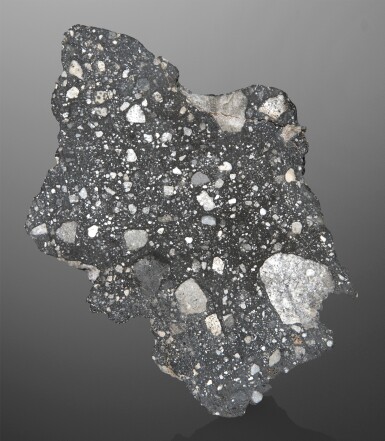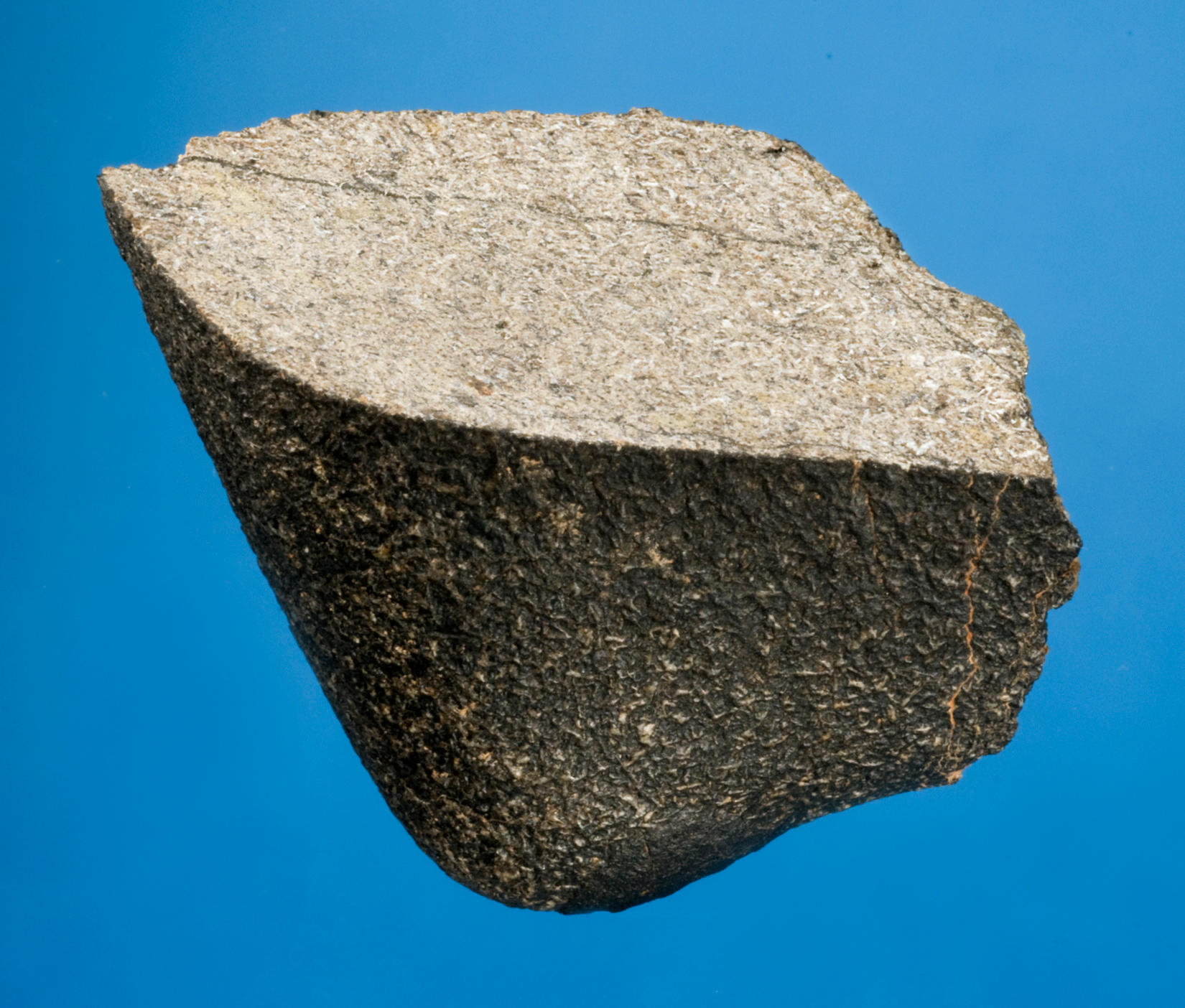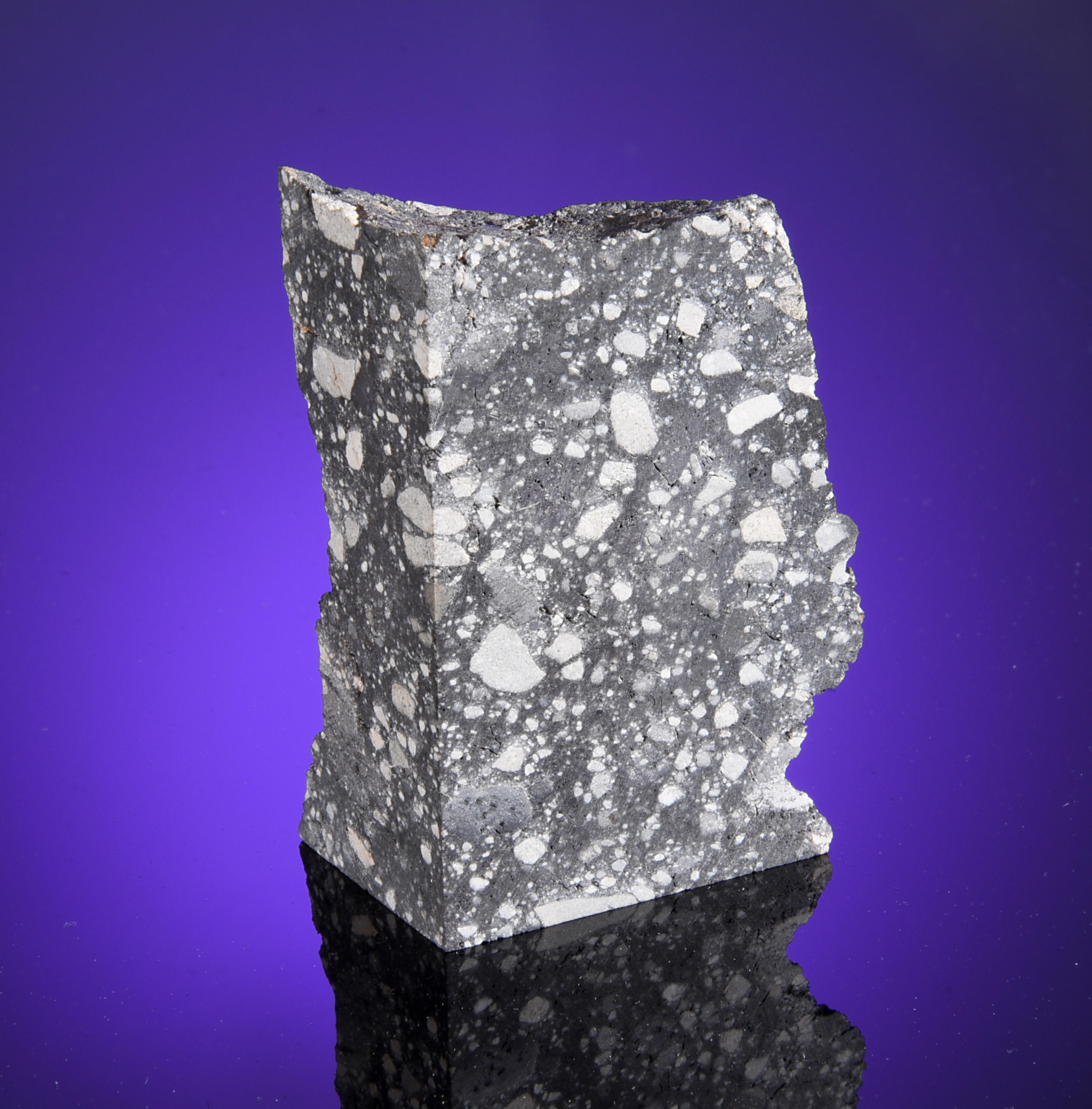Lunar, Feldspathic Breccia North West Africa – Morocco This is the third and last end piece in this catalog’s meteorite section. End pieces are sought-after as the reverse provides an expansive view of a meteorite’s external surface. This end piece is from a lunar meteorite—a piece of the Moon ejected from the lunar surface as a result of an asteroid impact, which later landed on Earth. As of March 1st of this year there were, as announced in the scientific journal of record, the Meteoritical Bulletin, 56 distinct lunar meteorites known to exist. The total weight of these specimens is less than 100 pounds—a large portion of which is not available to the public. The lunar meteorite from which this end piece is derived was classified by Dr. Tony Irving of the University of Washington and Dr. Delores Hill of the Lunar and Planetary Laboratory. The scientific abstract describing this sample accompanies this lot. Lunar specimens are identified by specific geological, mineralogical, chemical and radiation signatures. The most common minerals found on Earth’s surface are not found on the Moon; the minerals comprising the Moon’s crust are limited and readily identifiable. In addition, lunar rocks contain gases originating from the solar wind with isotope ratios that are very different than the same gases found on Earth. Moreover, lunar samples brought to Earth by the Apollo missions can be matched with suspected lunar meteorites. The clasts contained in the fine-grained impact-melt sample offered here include anorthic plagioclase, pigeonite and augite as well as kamacitic and troilitic metal. As was written in a recent abstract appearing in Lunar and Planetary Science, “With 6.1% FeO and 6.2 µg/g Sm, [NWA 4936] is the first lunar meteorite that could pass for a sample of regolith [lunar soil] from Apollo 16 [1972].” Divided among four pieces found in the same area in the Sahara by desert nomads, less than 600 grams of this material exists. It was the 4,936th meteorite to be classified after being found in a North West African corridor designated by the Meteoritical Society (the primary organization uniting hundreds of scientists throughout the world who study meteorites). This specimen contains an unusually large amount of free iron for a lunar sample and is attracted to a magnet. This is a select example of what is among the rarest objects on Earth: the Moon. Provenance: Macovich Collection. Weighs 2.424 grams; Measures 23 x 19 x 4mm (1.0 x 0 .75 x 0.15in)
Lunar, Feldspathic Breccia North West Africa – Morocco This is the third and last end piece in this catalog’s meteorite section. End pieces are sought-after as the reverse provides an expansive view of a meteorite’s external surface. This end piece is from a lunar meteorite—a piece of the Moon ejected from the lunar surface as a result of an asteroid impact, which later landed on Earth. As of March 1st of this year there were, as announced in the scientific journal of record, the Meteoritical Bulletin, 56 distinct lunar meteorites known to exist. The total weight of these specimens is less than 100 pounds—a large portion of which is not available to the public. The lunar meteorite from which this end piece is derived was classified by Dr. Tony Irving of the University of Washington and Dr. Delores Hill of the Lunar and Planetary Laboratory. The scientific abstract describing this sample accompanies this lot. Lunar specimens are identified by specific geological, mineralogical, chemical and radiation signatures. The most common minerals found on Earth’s surface are not found on the Moon; the minerals comprising the Moon’s crust are limited and readily identifiable. In addition, lunar rocks contain gases originating from the solar wind with isotope ratios that are very different than the same gases found on Earth. Moreover, lunar samples brought to Earth by the Apollo missions can be matched with suspected lunar meteorites. The clasts contained in the fine-grained impact-melt sample offered here include anorthic plagioclase, pigeonite and augite as well as kamacitic and troilitic metal. As was written in a recent abstract appearing in Lunar and Planetary Science, “With 6.1% FeO and 6.2 µg/g Sm, [NWA 4936] is the first lunar meteorite that could pass for a sample of regolith [lunar soil] from Apollo 16 [1972].” Divided among four pieces found in the same area in the Sahara by desert nomads, less than 600 grams of this material exists. It was the 4,936th meteorite to be classified after being found in a North West African corridor designated by the Meteoritical Society (the primary organization uniting hundreds of scientists throughout the world who study meteorites). This specimen contains an unusually large amount of free iron for a lunar sample and is attracted to a magnet. This is a select example of what is among the rarest objects on Earth: the Moon. Provenance: Macovich Collection. Weighs 2.424 grams; Measures 23 x 19 x 4mm (1.0 x 0 .75 x 0.15in)
.jpg)

.jpg)



.jpg)
.jpg)
.jpg)
.jpg)
.jpg)
.jpg)

.jpg)
.jpg)
Testen Sie LotSearch und seine Premium-Features 7 Tage - ohne Kosten!
Lassen Sie sich automatisch über neue Objekte in kommenden Auktionen benachrichtigen.
Suchauftrag anlegen